25: Williams Deacons Bank, and other stories
A Davenport history feature, written by Charlie Hulme
Davenport Station home | Index to History pages

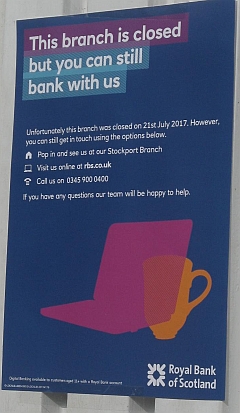
The Bank's Neighbours
Bayley's Shoes
Henry Bayley was a bootmaker. Born in Macclesfield around 1849, by 1881 he was listed in the census as a boot and shoe maker, living with wife Sarah, their young daughter Edith Maud Bayley, and an 14-year-old apprentice, at 21 Rowcroft Place, Stockport.

The 1891 census found them at 269a Wellington Road South with a new apprentice, Frank Clarke. The building (above) survives in 2017 as a restaurant.
In 1900, Edith Maud Bayley married Alfred Ernest Bromley, a drapery salesman, who moved in with his new wife and in-laws at 269a.
Alfred was born in Heaton Norris as one of a large family of Irishman John Garland Bromley.

46 Bramhall Lane in 2017.
Alfred Ernest Bromley was recorded in a house at 46 Bramhall Lane in 1911 as a manager, ladies' blouse manufacturer with his wife Edith and two children Olive Maud Bromley and Alfred Garland Bromley.
In 1912, Henry Bayley died, and his son-in-law Alfred, who appears to have learned the job from Henry, embarked on a change of career, giving up ladies' blouses in favour of the shoemaking business, with the assistance of his wife Edith, who was Henry Bayley's only child. Initially, they carried on at the old premises, soon afterwards moving to one of the then newly-converted shops in Bramhall lane, no.195. His father John Garland Bromley, who latterly lived at 62 Atwood Road, Didsbury, died at No. 195 in 1915.
Alfred and Edith retained the Bailey name for the business, and it appears to have flourished, as in 1919 they were able to purchase from Williams Deacons bank the newer shops at 223 and 225 Bramhall Lane, perhaps a slightly more up-market location nearer to the middle-class residences of Davenport.
223 and 225 Bramhall Lane were combined into a double-fronted store: whether this was the original plan we cannot be sure. Bayley's Shoes, as it was later known, served the area for many years. The Register compiled in 1939 shows Alfred as 'Boot and Shoe Dealer and Repairer' and Edith as 'Manageress, Shoe Shop.' At that time they were living at 'Penryn', 15 Oakfield Road, Davenport. Edith died in 1944; her husband was named as executor at that time; his date of death eludes us at present.
(His son Alfred Garland Bromley, who became a wine and spirit merchant, later lived in Bramhall and died in Stockport in 1986.)
The firm continued under new management for a long time: 'Bayley Shoes Ltd' was still operating from 225 in the 1980s. The 1951 Electoral Register has Roland and Thelma Bayley, no doubt relatives of Henry, living at 233, presumably above the shop.
Later, the rooms above, taking the number 233, housed a ladies' hairdresser for many years under different names; the entrance can be made out in the 1980s postcard.
The 1990 telephone directory shows it was still a shoe shop, but under the name of John Plant, a national chain. Soon afterwards, it became 'Schuh Mode' which we dimly recall selling 'Van-Dal' shoes and other exotic footwear. (The company also had branches at 29 Market Street, Marple and 75 King Street, Knutsford.)
By 2004 the shoe connection had finally been lost, and the store became a branch of tastefully-named off-licence chain 'Bargain Booze' which still operates there in 2023, its shopfront now in a more startling livery than when it first opened. Bargain Booze, with over 600 stores mostly in Northern England operates a franchise model; it does not own the store which belongs to a property company.
August 2017 saw a complete refurbishment of the shop, which has a reputation for selling a wide range of beers, as its Twitter feed reveals.
227 Bramhall Lane
No. 227 retained in the Bank's ownership for many years, rented to a series of shopkeepers. A 1934 directory lists A.K. Pilgrim, Draper, and from 1951 to (at least) 1965 it was a Chemist's shop run by Harry and Enid Smith, and by the 1980s, 'Fashion in Fabrics', selling material for home dressmakers. A local resident recalls 'When I was younger I was in the Brownies at St.Georges church. Every harvest time we had a festival, we used to purchase the fabric from there to make the outfits. It was owned/run by two lovely ladies.' Can anyone remember their names?

In 1998 the shop was sold to Violet Ann Barrow to become first a dress agency called 'Assemblage', and later Davenport school and leisure outfitters, later re-named 'Badged by Davenports', which operated until 2020 (under new management from 2010) when it was merged with larger business F.R. Monkhouse, which operated from Cheadle Hulme shopping precinct, and the Davenport shop closed. The shop was advertised at a rent of £12,750 p.a; in business at 227 in 2023 is 'The E-Cig & CBD store', a branch of a chain founded in 2017. Their website tells us that they are 'one of the largest electronic cigarette companies in the UK with over 55 stores nationwide. '
On the Map
Some old maps record the changes. For maps showing the early history of the site, and the story of its owner, Winifred Countess of Dundonald, see our feature Who Was Winifred?
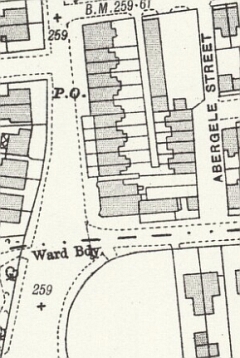
This extract dates from 1917.The five houses 227 to 231 still have their front gardens.
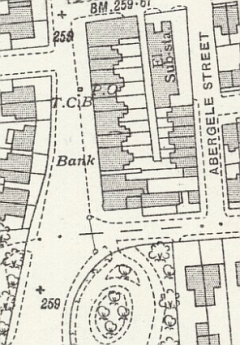
1937, and the 'green', having been taken over along with the big house 'Bramhall Mount' opposite, is a small park. The Post Office has gained a Telephone Call Box.
223/225 have been merged to form the shoe shop, and 229/231 merged to create the bank branch. The electricity sub-station has replaced what was perhaps a stable block.
The buildings to the south, 233 and 235 appear to have also been built on Williams Deacons Bank land; they will need a feature of their own.
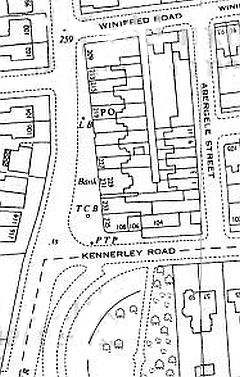
1959. Bramhall Lane narrowed to create the parking area seen in the postcard view.
Never happened (1)
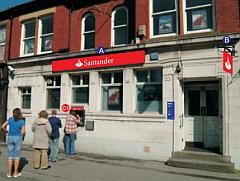
2011-12 proposal
.
.
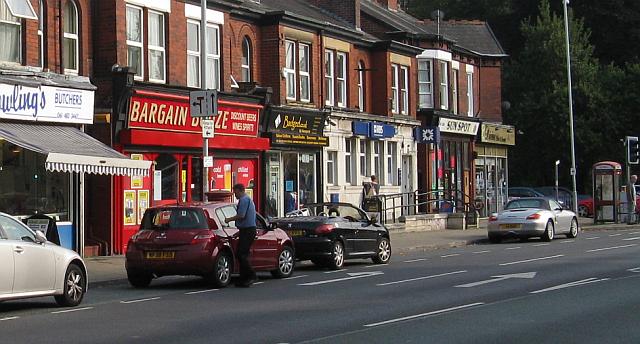
To trace the history of the Bramhall Lane branch of the Royal Bank of Scotland (seen above in 2008) we need to travel back in time to the 1890s, when building development began on two fields which, according to one writer, had been donated by the Davenport estates to the Bamford Hesketh family with the intention that the rent would support Stockport Grammar School. A local builder, William Winbolt, erected two terraces facing Bramhall Lane, with larger houses at each end (one of which became his family home). The two terraces appear to be one, but the linking section can be seen if you look carefully, The story of the northerly half, 209 - 219 Bramhall Lane, and also no. 221, is told in our pages on John Williams and Sons and Davenport Post Office.
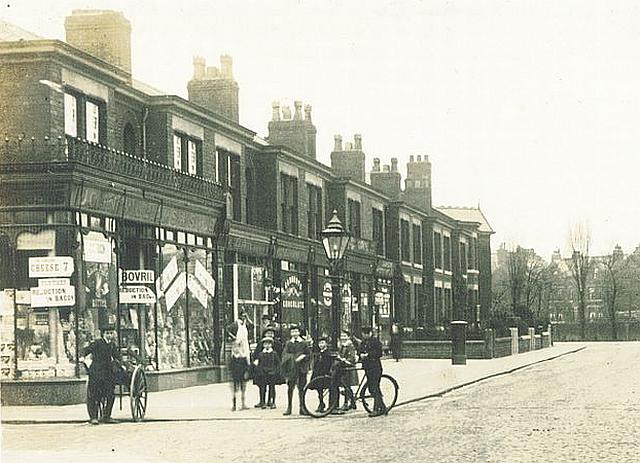
The original developers had no intention of creating the shopping street we know today; the middle-class residents of Davenport no doubt expected their necessities to be delivered to their homes, and the workers' terraces had their own 'corner shops' but as the new century dawned, so did the 'consumer society' and this part of Bramhall Lane, near the station and the junctions with Garners Lane and Kennerley Grave Lane (as it was then) became an obvious place for a retail focus. The postcard from 1914, above, shows the shops developed by John Williams, and beyond, the houses still in residential use, with the remaining examples of the gardens which originally fronted all the buildings.
The Great War would have delayed any further developments, until in 1919 the southern terrace, 223 - 231 Bramhall Lane, was purchased by Williams Deacons Bank for conversion to a bank branch and adjacent shops to made available to local businesses. The residents, who presumably rented the houses, must have been given 'notice to quit'. The bank branch appears in a 1922 telephone directory, but may have been opened a little earlier.
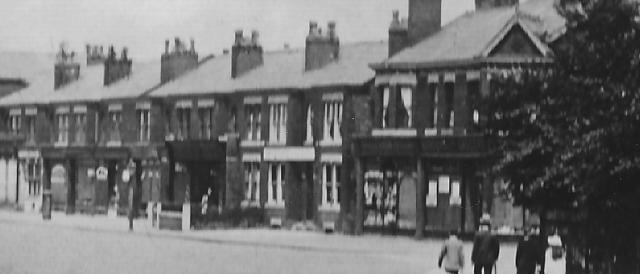
Most of the historic views we have of the shops are details from postcard views taken from the station bridge, which lose definition when enlarged, but are still worth examining. The one above, which is no exception, seems to date from around 1920, when the conversion was not quite complete. No. 227 stubbornly retains its front garden, and the board (sadly illegible) above the entrance to 229-231 suggests that the Bank was in business, but the characteristic portland stone frontage had yet to be applied. This may date froom 1935.
The basis of Williams Deacons was a company founded in the north-west of England, established in 1836 as the Manchester and Salford Bank. In 1890 the expanding firm took over their London agent, Williams, Deacon & Co. and moved its headquarters to London, It traded for a while as 'Williams Deacon & Manchester & Salford Bank' Ltd before adopting the simplified title in 1901. Having grown by acquiring several smaller banks over the years, the company was purchased by the Royal Bank of Scotland, keen to expand into England, in 1930, but did not initially change its trading name for another four decades.
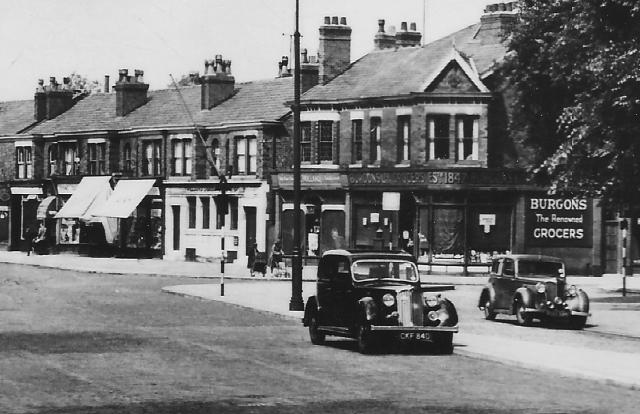
The postcard picture above possibly dates from the late 1930s; the cars have been identified as a 1930s Rover, either a 10 or 12 HP, on the left, and almost certainly a late 1930s Lanchester 10 HP, the smallest Lanchester ever produced, would have had a preselector gearbox. No cash machine, or disabled ramp, in those days of course, and the building has a symmetrical appearance, with a door at each end. The northerly door, probably the entrance to the manager's flat above, was later removed and replaced by a window. Notice the flagpole attached to the building; a 1960s postcard shows very much the same scene. Part of what we now know as the 'green' was used as parking space in those days; a 1970s proposal to turn it completely into a 67-place car park was passed by the Council planners but abandoned after a public outcry orchestrated by the residents of the nearby Davenport park private estate.
Former employee Peter Cross has written some of his memories of the 1960s for us:
I joined the Davenport branch of Williams Deacons Bank in September 1963 from school. I started, of course, as 'office junior' and within the first few minutes I was shown the boiler room in the basement and how to stoke the coke-fired boiler -more importantly how to keep it going all day! My salary was £330 per annum (male and female staff had different pay scales both based on age).Williams Deacons Bank quietly served the community for many years, with name changes as banks merged and were sold. In 1969, The Royal Bank of Scotland merged with National Commercial Bank of Scotland, and in 1970 Williams Deacons became Williams and Glyn's Bank when owners the Royal Bank of Scotland merged it with Glyn, Mills & Co and the English and Welsh branches of The National Bank. In 1985 The Royal Bank of Scotland Groupís two major subsidiary holdings, Williams & Glyn's Bank and The Royal Bank of Scotland, were fully merged as The Royal Bank of Scotland plc.
Another important job was to go out and buy the manager's lunch from the shop just over the railway bridge. This was usually something from the "boil in the bag" range which was new to me! The staff consisted of the Manager (Mr Morton) who seemed very old but was at least twelve years younger than I am now, then below him the Chief Clerk, just as old, then the Cashier and a girl who operated a posting machine. All were cashiers except me!
It was a standard small branch of its time with dark wooden furniture, a long sloping desk at the back with a hand operated listing/adding machine and a row of hand-written ledgers which had to be brought up steep stairs from the strong room and back again every day (another of my jobs!). There were none of the 'sales targets' of today and it was a very different working world. I enjoyed my time there; with the odd exception the customers were very nice people. Opening hours were 10am to 3pm and providing the cash. etc., balanced at the end of the day we usually got out about 5pm. The branch also opened Saturday mornings when the male staff were permitted to wear a sports jacket rather than a suit.
A 20-minute cycle ride and I was home.
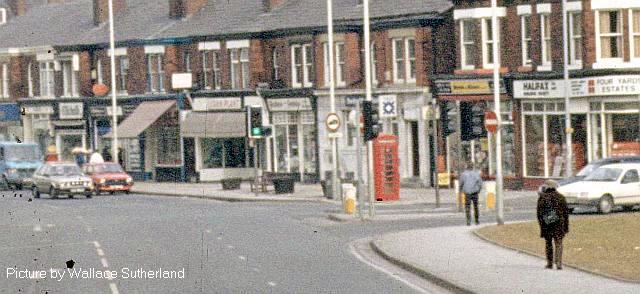
This image is enlarged from a small part of a 35mm slide taken by the late Wallace Sutherland in 1986 and scanned at the highest resolution possible. Some of the shops are known and can be identified. Left to right: The blue facia of 209-213 'Lo-Cost', 215 Ladies' outfitter 'Judith', 217 Michelle ladies' fashions, 219 The Post Office, 221 Bowling's Butchers, 223-225 John Plant shoe shop, 227 'Fashion in Fabrics', 229-231 Royal Bank of Scotland, 233 'Candy Corner', 235 Four Yards Estates.
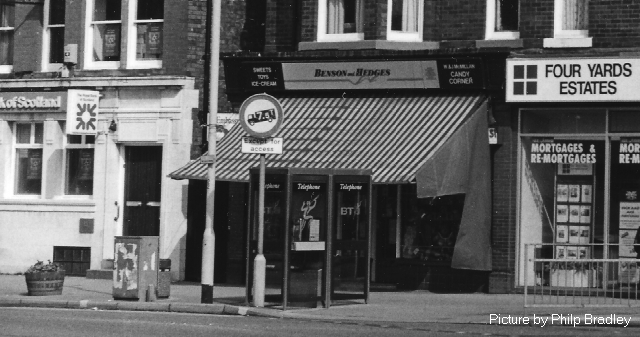
From 1985 onwards the branches were branded as Royal Bank of Scotland, and the full name appeared on a blue board above the window, covering up the remains of the Williams Deacons Bank name. The style can be glimpsed in the picture above, taken by Philip Bradley in 1989. The ramped access for wheelchairs was yet to be built, obscuring the cellar window.
In 2000 the company bought the National Westminster Bank (NatWest), resulting in the closure of many NatWest branches, including the one down the road at 197 Bramhall Lane, which in 2017 housed the 'Crowning Glory' hair salon.

In 2003 the company decided to re-brand itself using the initials RBS with the 'daisy wheel' symbol alongside and the full name in small letters below, but the long board could not be removed without revealing what was behind it, so the new short 'RBS' board had to fixed over the old with its letters removed. the and the 'Daisy Wheel' logo - introduced in 1969 and said to be inspired by four piles of nine coins arranged in a square - attached in the centre.
The twenty-first century saw the Royal Bank of Scotland encounter turbulent times, well-chronicled in the Media, following some unfortunate decisions by senior management, and leading to its rescue by the Government as being 'too big to be allowed to fail', but the Davenport branch carried on its daily work, enhanced by a cash machine, and in 2003 by a disabled ramp avoiding the steps at the front door.
In November 2012 a man in a grey hooded tracksuit walked casually along Bramhall Lane, past the station's CCTV camera and into the bank, where he threatened the staff with a gun (later said to be a replica) and walked back towards Bramhall with £3000 in cash. The following week, he repeated the action. Soon afterwards, a man from Bramhall was arrested and charged. From that time on, customers had to press a bell-push to request entry to the building.
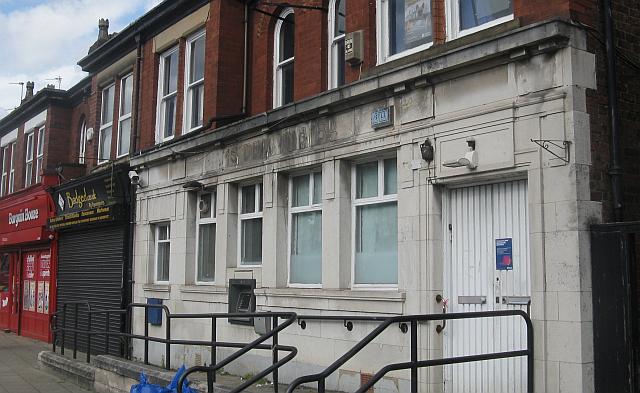
The bank just after closure. The metal bracket which supported the flagpole is still in place between the upper windows. The former door space at the far end had been re-used to provide a 'night safe' where local businesses could deposit their takings outside opening hours, but this had been out of use for some years by the date of a 2008 proposal to replace it with an additional cash machine, which was initially refused by Stockport Council.
As telephone, and later internet, banking became available, the local branch was no longer many people's main contact with their bank, and over-the-counter business decreased In Summer 2017 a placard, apparently made by the staff of the branch, appeared outside warning that RBS were closing the branch, and asking people to complain to their MP. The message was repeated on paper flyers which the local 'Big Issue lady' was recruited to hand out to passers-by. The placard was later added to with a hand-written 'we did try' sticker and the branch closed on 21 July 2017. RBS produced a leaflet explaining the decision explaining that although 85 customers were still using the branch on a regular basis, the number of transactions at Davenport branch had dropped by 24% since 2011. 53% of customers at the branch were, RBS assured us, active Digital Banking users; a low figure, perhaps reflecting the age profile of the area. Others, it was suggested, could bank at the Post Office, or visit RBS branches in Stockport, Cheadle Hulme or Hazel Grove. All those branches also closed shortly afterwards.
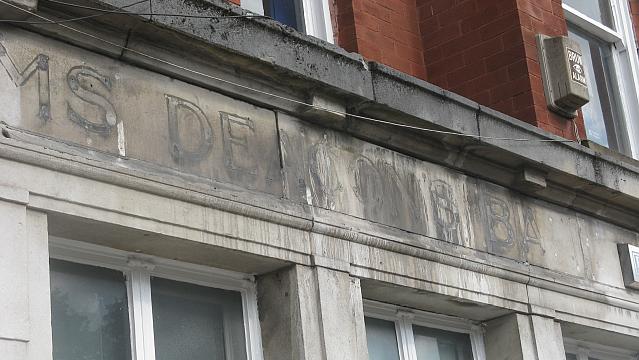
The RBS name-board was removed, revealing traces of the old metal lettering (above), and blue bags of rubbish were dumped outside. So ended almost a century of service. Our thanks are due on behalf of Davenport residents to all the staff who worked there over the years.
The cash machine remained in service after the closure, not for long. Use of the building for non-banking purposes in the future would appear to require major alterations, and be subject to the requirements of the Cale Green Conservation Area. In 2020 when this page was revised, it was still standing empty.

Never happened (2): RBS was required by the European Union to divest a portion of its business after HM Government took an 84% stake in the group during the 2008 United Kingdom bank rescue package, which the EU classed as state aid. In 2011 it seemed that Spanish bank Santander would be taking over the bank branches, and a planning application was submitted to change the exterior signage to their red style, but this deal was never completed.
Later, it was proposed to re-brand and sell off the branch network as 'Williams and Glyn' - minus the 'apostrophe s', said to be owing to the difficulty of using an apostrophe in branding and website addresses. In 2016, they applied to Stockport Council for planning permission to change the branding of the Davenport branch; the above mock-up is from their application. However, still no buyer was found and in 2017 - in the aftermath of 'Brexit' - it was agreed that RBS would retain the branches, paying large sum into a fund intended to increase competition in the UK Banking sector. The aftermath has been the closure of many branches.

Autumn 2008.
Update March 2023
There was a planning application in 2020 for 'Change of use and sub-division of ground floor from Class A2 to retail (A1) and office (A2), upper floors to 3 residential flats and associated external alterations including new entrances and restoring window with window replacements.' The proposed new entrance was a re-opening of the doorway seen in the 1930s image,

This was given permission, but it never came to pass. After a long empty period, we now have at the former bank another 'pound-shop' style business, in direct competition with the existing store 'Pound Stop' at no. 201, complete with the usual collection of products on the pavement and spelling error on the facia.
Sources used for this feature include street and Telephone Directories at Stockport Heritage Library and in our own collection; Ancestry.co.uk; and the 1939 Register on Findmypast.co.uk. The maps are from the National Library of Scotland. Details of the 1930s cars were kindly provided by Andy Stobbie and Terry Borton of the Panther Car Club. Thanks as always to Sue Bailey of Woodsmoor for her support, and access to her father's photographs; and to Peter Cross and Violet Barrow for their contributions. Thanks also to the other local residents who have added to the picture.
Written by Charlie Hulme, last updated March 2023
Comments and corrections welcome at info@davenportstation.org.uk